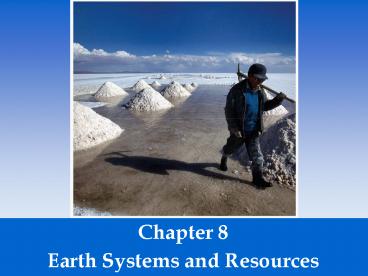Earth Systems and Resources - PowerPoint PPT Presentation
Title:
Earth Systems and Resources
Description:
Title: Chapter 8 Author: cmayer Last modified by: WLHS_Teacher Document presentation format: On-screen Show (4:3) Other titles: Lucida Grande Arial Wingdings 2 ... – PowerPoint PPT presentation
Number of Views:43
Avg rating:3.0/5.0
Title: Earth Systems and Resources
1
Chapter 8 Earth Systems and Resources
2
The Earths Layers
- Core - the innermost zone of the planet made of
nickel and iron. - Mantle - above the core containing magma
- Crust - the outermost layer of the planet.
3
(No Transcript)
4
The Earths Layers
- Asthenosphere - the outer part of the mantle,
composed of semi-molten rock. - Lithosphere- the brittle outermost layer of the
planet that is approximately 100 km thick.
5
Convection and Hot Spots
- The Earth is very hot at the center.
- This heat causes plumes of hot magma to well
upward from the mantle. - Hotspots - places where molten material from the
mantle reach the lithosphere.
6
Alfred Wegener
- Proposed Theory of Continental Drift (1915)
- Supported theory with diverse fields of study
- Geology
- Geography
- Biology
- Paleontology
- Needed a mechanism to explain how it worked!!!
7
Theory of Plate Tectonics
- Plate tectonics - the theory that states that
Earths lithosphere is divided into plates, most
of which are in constant motion. - Proposed in 1960s
- Made possible by sonar from WWII
8
Tectonic Plates
9
Consequences of Plate Movement
- Volcanoes - as a plate moves over a hot spot,
rising magma forms a volcano.
10
Types of Plate Contact
- Divergent plate boundaries - when plates move
apart from one another. - Convergent plate boundaries - when plates move
toward one another and collide. - Transform fault boundaries - then plates move
sideways past each other.
11
(No Transcript)
12
(No Transcript)
13
(No Transcript)
14
(No Transcript)
15
Faults and Earthquakes
- Faults - a fracture in rock across which there is
movement. - Earthquakes - occur when the rocks of the
lithosphere rupture unexpectedly along a fault.
16
Faults and Earthquakes
- Fault zone - large expanses of rock where
movement has occurred. - Epicenter - the exact point on the surface of
Earth directly above the location where the rock
ruptures.
17
The Rock Cycle
- Rock cycle- the constant formation and
destruction of rock.
18
The Rock Cycle
- Igneous rocks - rocks that form directly from
magma. - Intrusive igneous- form from within Earth as
magma cools. - Extrusive igneous- from when magma cools above
Earth. (ex. A volcano that ejects magma out will
form this) - Sedimentary rocks - form when sediment such as
mud, sands, or gravels are compressed by
overlying sediments. - Metamorphic rocks - form when sedimentary,
igneous or other metamorphic rocks are subjected
to high temperatures and pressures.
19
Elemental Composition of the Earths Crust
19
20
Reserves
- Reserves- the known quantity of a resource that
can be economically recovered.
20
21
Types of Mining
- Surface mining- removing minerals that are close
to Earths surface. - Strip mining - removing strips of soil and rock
to expose ore. - Open pit mining - the creation of a large pit or
hole in the ground that is visible from the
surface. - Mountain top removal - removing the entire top of
a mountain with explosives. - Placer mining - looking for metals and stones in
river sediments.
21
22
Types of Mining
- Subsurface mining- mining for resources that are
100 m below Earths surface.
22































